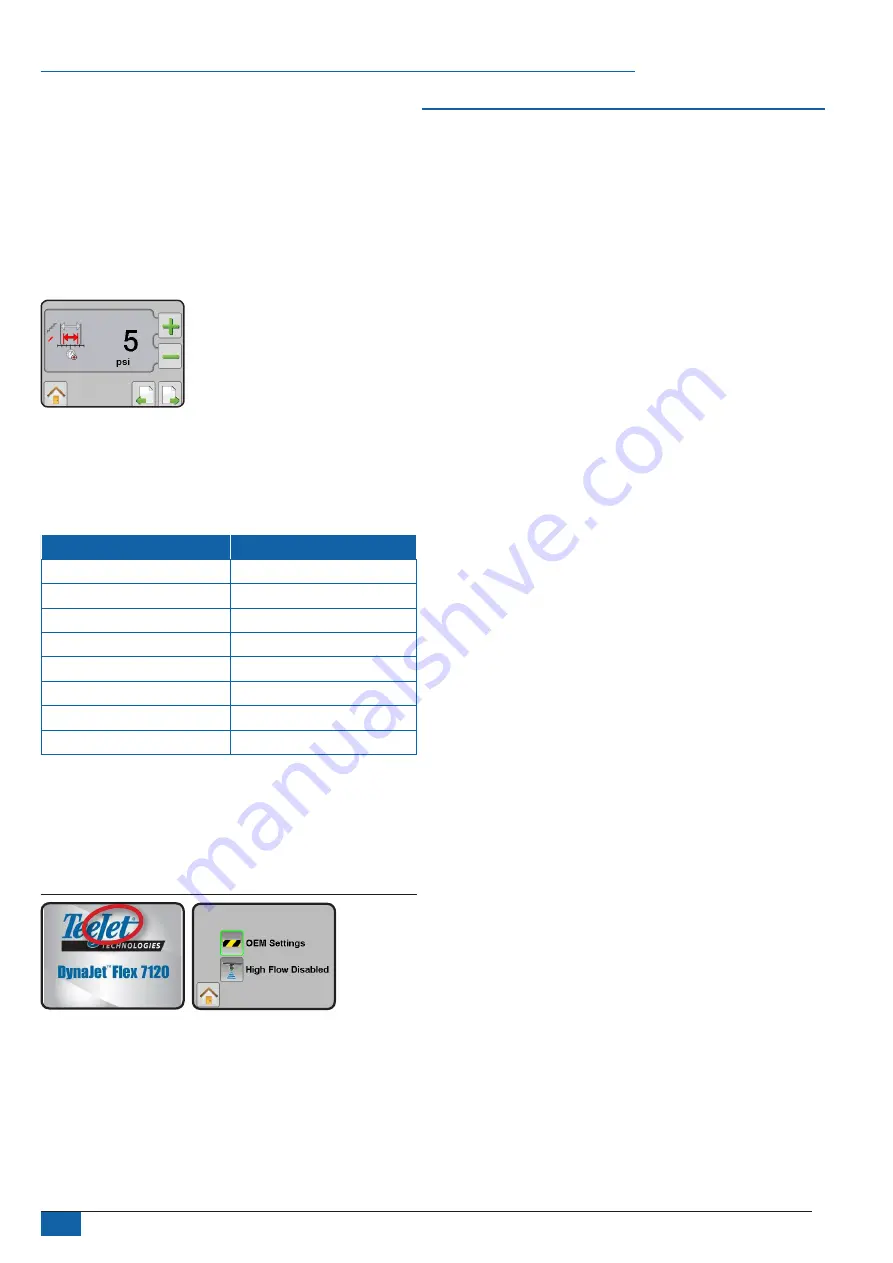
13
www.teejet.com
DynaJet
®
Flex
Coarse gain off
This setting determines the threshold at which coarse regulation is
switched off and fine regulation takes over. Value is shown in the
pressure units previously chosen. Range is 0.07 to 1.38 bar.
This value must be lower than coarse gain on. For example, if
operating in bar units and with a setting of 0.28; coarse regulation will
be switched off (and fine gain becomes active) when the difference
between target and actual pressure is 0.28 bar or less. Regulation
will remain in fine until the error reaches the coarse gain on value
described above.
OEM settings
The settings described below are engineering and development
values used in development of the DynaJet Flex system. Do not
alter these settings unless directed by TeeJet Technologies support
personnel.
Setting Description
Default Value
PWM frequency
10 Hz
On pulse duration
38
Hold current frequency
10 counts
Hold current duty cycle
5 counts
Phase offset
128 counts
Jump point
0.35 bar.
Maximum duty cycle
80% (all ON above this value)
PWM off time
0 counts
Enable/disable options
To enter the OEM setup:
1.
Press the TeeJet logo 3 times within the first three seconds of
the splash screen being displayed. The console will beep to
acknowledge the OEM option has been activated.
Figure 17: OEM setup
TUNING DYNAJET®
1. Identify the speed range, rate range and system pressures for
the application. Ensure the operating conditions are compatible
with the nozzle capacity, speeds and duty cycles shown in the
TeeJet PWM nozzle selection guide.
2.
Using the identified speed range based on nozzle selection use
the rate controllers test speed or simulated speed to target a
desired application rate and droplet size.
3. Fine tune the regulation performance of the rate control system
and the DynaJet system.
a. Typical settings used for DynaJet fine-tuning include fine gain,
coarse gain, coarse gain on and coarse gain off.
b. Coarse gain on must be a higher value than coarse gain off. A
good starting point for coarse gain on is a pressure value that
is about 35-40% of the target pressure.
c. Coarse gain off value is typically is about 25% of the target
pressure, or 0.3 - 0.6 bar lower than coarse gain on.
d. Coarse gain on and coarse gain % are used to make major
adjustments to pressure regulation. Once coarse gain has
brought pressure near target; coarse gain off and fine gain will
influence the smaller adjustments.
e. Coarse gain should be increased if large pressure
adjustments need to be made more quickly.
f. Fine gain should be decreased if actual pressure constantly
moves across the target pressure.
DynaJet and the existing rate controller are two control systems
that must coexist. Because DynaJet is a second control device that
is installed on the same liquid system, users should be prepared to
adjust the rate controller regulation settings to harmonize the two
system. For example, if subtle changes in duty cycle on DynaJet
induce noticeable rate or pressure oscillations, the rate control
regulation gain settings may need to be reduced. Placing the rate
control system in manual regulation mode during the tuning process
will help determine if oscillations are being caused by the DynaJet or
by the rate controller.
TeeJet control systems like 844E, 854 or Radion will typically perform
better with DynaJet when their coarse and fine regulating speeds are
reduced by 2-3 units.
General rule of thumb under normal operating conditions for flow rate
changes; DynaJet in combination with the rate controller should have
rate/pressure stabilized in ~ 2-3 seconds.
Summary of Contents for DynaJet Flex 7120
Page 23: ......























